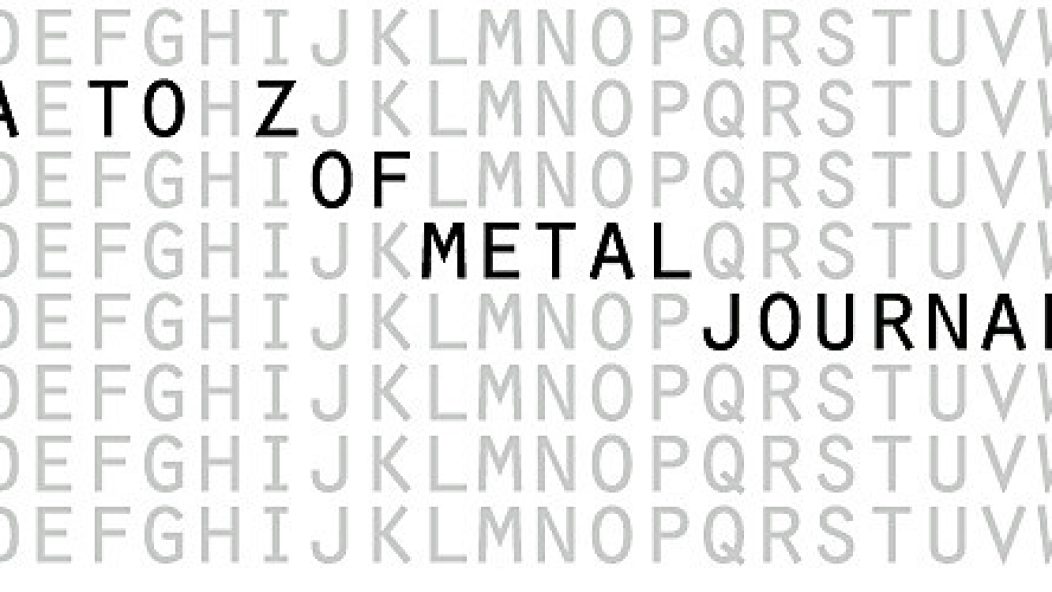
The A to Z of Metal Journalism
…
Recently, British indie press entity The Stool Pigeon released an alphabetical list of overused terms and ideas present in music journalism (take a gander). And while many of us at Invisible Oranges nodded and face-palmed at some of the terms and phrases we were particularly guilty of using to death (‘angular riffing’ made more than one of us stare at our shoes in shame), I found that this list was sorely lacking in phrases I specifically drive into the ground like railroad spikes. Upon further consideration, I realized that metal journalism, like the music form it covers, is its own beast with its own rules, and therefore warrants its own list.
So, for all you young aspiring metal journalists (turn back, dear fucking God TURN BACK), I provide you with a twenty-six part list of tried-and-true terms and concepts to make your drab review into a fire-breathing heroin-drinking skull-shitting hellbeast that will no doubt earn you up to seventy-five whole dollars. Enjoy this, Scab Casserole’s own Metal Journalism Alphabet.
…
A is for Ax: When you’ve said guitar too much, and you want to make a musician sound like some sort of medieval warrior, call it an ax. Variations include ax-man, ax-worship, and grinding that ax for a long time. Special tip: don’t include the ‘e,’ like for a proper tree-chopping axe. Why? It’s a mystery.
B is for Bone-Crushing: If something is especially hard-hitting or has a thick, riffy sound, it crushes bones. Whether the bones are ground afterwards, or which of the 206 bones in a human skeleton are crushed, does not matter, so long as bones are crushed, preferably by large, powerful breakdowns.
C is for Chainsaw Guitars: If you want to describe a guitar as having lots of treble and an insane amount of distortion, they are best compared to chainsaws, which are obviously the most metal power tool due to their use in the butchering of cinematic teenagers. Not to be confused with chainsaws used like guitars, such as that on Jackyl’s “The Lumberjack.”
D is for Doom: A versatile term that can refer to music’s slow pace, depressive subject matter, or looming evil within a song. Also a genre with a wide range; if using to describe the genre, make sure to do it in such a way that comments-section posters can question indefinitely. For instance, Grand Magus is a doom band. Discuss.
E is for Entrenched: Describes a band deeply invested in a very specific style and metal tradition, and helps continue the comparison of playing heavy metal to dying at war. For example, Cannibal Corpse are entrenched in brutal death metal—they’ll play nothing else, until they perish in a bloody heap.
F is for Furious, Fierce, and Fearsome: These three adjectives that mean basically the same thing—the music is energetic and everyone sounds incredible angry. But though similar and alliterative, your editor will probably overlook the use of at least two, if not all three, in a review.
G is for Guttural: Describing extreme metal vocals as “hoarse shouting” or “Cookie Monster language” or “extended throat clearing” just doesn’t sound glottal enough. Use ‘guttural,’ Generally helpful in distinguishing all non-clear vocals from clear vocals.
H is for Hipster: Make sure to bestow this title on anyone who does not meet your criteria for trueness, or has gotten into metal for reasons you don’t deem worthy (see ‘W’). Also a designated subgenre of progressive metal that includes everyone from Liturgy to Kylesa to Abigail Williams, for some reason.
I is for Infectious: Metal is never ‘catchy.’ ‘Catchy’ is a word for shitty pop tunes trying to ‘catch’ the cattle-like prey of mainstream music listeners. If a part of a metal song gets stuck in your head, it is because it has infected you, like a terminal disease.
J is for Jaunty: A literary term best used to describe upbeat songs with major keys and a galloping tone. Rarely a positive word, though when it is it denotes incredible music ability. Usually joined by other words such as ‘jaunty rhythm’ or ‘jauntiness.’.’
K is for Kvlt: Though somewhat amorphous in its meaning, ‘kvlt’ refers to anything with intense overtones of unexplainable darkness, and a sense of obscurity in an album’s creation (see ‘P’) and distribution. A warning: if you spell the word properly, like the subversive religious group, you are not kvlt.
L is for Legendary: When a metal musician is especially talented or well-known, they are the stuff of legend, like King Arthur or werewolves. Therefore, they must be described as such, as though their picture were found inside of a weathered codex unearthed in the basement a desecrated church. It should be noted that any death metal album made before 1995 is legendary.
…
The alphabetical guide to metal journalism continues with M….

…
M is for Metallica: If possible, a metal journalist should always reference Metallica, or a member of Metallica, or one of their pre-Black Album records, as they are a band whose work is considered especially metal but who any reader, metalhead or otherwise, will know.
N is for Niche: Use this word to describe a specific cross-section of fans or subgenre within which a band is entrenched (see ‘E’). This is also a qualifier to both commend and condemn a given musician who plays for and appreciates only their given specific subgenre.
O is for Old-School: A term meant to compare a band to the bands that originated their genre. Usually denotes a level of noisiness, speed, and high-speed tempo among metal musicians that originated during metal’s early days only due to financial strain (being poor is incredibly old-school).
P is for Production: An album’s production is almost as important as the music thereon, and should always be commented on. The rules depend on the band—sometimes, bad production is good (see ‘K’) and good production sucks. Nonetheless, mentioning an album’s production value and what went into the creation of its ‘sound’ is a must.
Q is for Quartet and Quintet: ‘Band with four guys’ and ‘band with five guys’ respectively. They are essential for reducing the word count, and make a band sound like some kind of alien species or superhero team.
R is for Record: When one has used ‘album’ too many times, switch to ‘record.’ Metalheads’ obsession with tradition and antiquity is honored with this term, as it hearkens back to the days of vinyl. Be sure to have at least one vinyl record in your possession, in case you are called out by some metal historian (see ‘W’).
S is for Slay: Something that is especially good and intense ‘slays.’ This is both a reference to thrash metal titans Slayer and to medieval culture, which is incredibly metal and in which people were constantly slaying things, which was like killing, only with swords and a higher purpose granted by some coin-flicking royal.
T is for Technicality: Technical prowess, especially in death metal, thrash, and any sort of math-themed metal subgenre, must be commented on. It can also be confronted as a way of explaining that technical strength is not the pinnacle of musical progress; for example, Yngwie Malmsteen is technically adept, but his songs suck a dog’s lipstick.
U is for Ugly: Ugliness is golden in metal, and so metal journalists should laud bands for making music that swells their collective gorge. Terms such as ‘sick,’ ‘hideous,’ and ‘vomit-inducing’ are good indications of a band’s ugliness. Ugly musicians are especially welcome, and should be hailed for their lack of physical symmetry and hygiene. As fictional Internet luchador Strong Bad once said, “The gift of death metal does not smile upon the good-looking.”
V is for Vest: A recent addition to the metal journalist’s arsenal due to a resurgence of the denim vest, or ‘battle jacket,’ that has taken place in recent years. Include mentions of vests and the patches that go on them to determine if a band is old-school (see ‘O’) or kvlt (see ‘K’).
W is for Worthy: Metal bands must earn their place in metal. Use of ‘worthy,’ both within a review or as a personal judgment, determines a band’s importance and longevity within your personal pantheon. Also connotes a reluctant approval, specifically as part of the phrase “worthy of the praise they’ve…”
X is for Xenophobic: A handy-dandy term to describe a racist musician whose music you still kind of like. “Xenophobic” implies some sort of concerted and/or intellectual racism, justified by personal beliefs or ideologies, rather than your run-of-the-mill racism. Still means someone’s an ignorant fucking Nazi.
Y is for Youth: Reference your youth as a metalhead. Mention the first time you saw whatever band you’re interviewing or reviewing. Focusing on your youth reminds everyone of that beautiful moment when metal first ignited the fires beneath their throbbing heart. But always ‘youth,’ never ‘childhood.’ Childhood is a place for trauma and a brief love of showtunes.
Z is for Zero Stars: This is the fantasy of every great metal journalist—to receive an album so bad, so completely repugnant, that you can give it no stars. A truly metal journalist will do their best to shy away from this at all costs—it has a decent solo? That’s a star—but still dreams of the day that a zero-star-worthy album flops on their desk and they can really skewer it. Some day, friend, your piece of shit will come.
…











